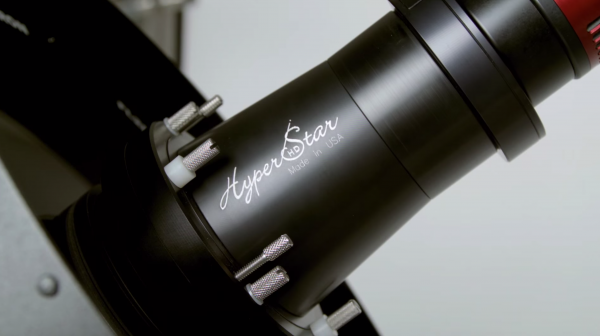
Equipment for HyperStar Imaging
The HyperStar system works with a variety of Schmidt-Cassegrain telescopes and many models of cameras. There are combinations to fit different budgets, interests, and skill levels. One of the main advantages of HyperStar is that it makes imaging easy to learn, so it is ideal for beginning imagers. However, it is also capable of delivering very high-quality images very quickly, making it perfect for advanced astronomers interested in taking beautiful pictures or even hunting the sky for comets, asteroids and supernovae.
Compatible Telescopes
Currently, there are HyperStar lenses available to fit the following models of Schmidt-Cassegrain telescopes, including the new Edge HD versions:
- Celestron 6" SCT
- Celestron 8" SCT
- Celestron 11" SCT
- Celestron 14" SCT
Note that some telescope models are "HyperStar-ready", meaning they already have an easily removable secondary mirror assembly. Other telescopes can be converted by installing a conversion kit from Starizona.
Compatible Cameras
A variety of cameras will work with the HyperStar lenses, but there are some limitations. The camera cannot be too large or it will obstruct too much of the telescope aperture. Larger telescopes can use larger cameras. Also, the size of the sensor that can be fully illuminated by the HyperStar is dependent on the size of the telescope. Larger scopes allow larger lens elements to be used in the HyperStar, so bigger sensors can be illuminated.
Cameras compatible with 6" HyperStar lens
- ATIK
- StarlightXpress
- Mallincam
- QHY
- ZWO
Cameras compatible with 8" and larger HyperStar models
- Astrovid StellaCam
- ATIK Cameras
- Mallincam
- Meade DSI & DSI Pro (all models)
- Orion StarShoot I & II
- SAC Imaging Cameras (all models)
- SBIG ST-237
- Starfish Cameras
- Starlight Xpress Cameras (all models except H35/36)
Additional cameras compatible with 11" and larger HyperStar models
- Canon EOS and Nikon Digital SLR Cameras*
- QSI 500 Series (all models)
- SBIG ST-402/ST-8300
- SBIG ST-Series Cameras (all models)
Additional cameras compatible with 14" HyperStar models
- Orion StarShoot Pro
Recommended Setups
For a beginning imager, the ideal camera is a one-shot color model. These cameras eliminate the need to take individual red, green, and blue-filtered exposures to create a color image. The color rendition obtained from a one-shot color camera is very accurate. While color cameras tend to be less sensitive than monochrome models, there are two points that make this less important. For one, the total time spent imaging is not any longer, because the monochrome camera requires three times as many images--the color camera is not that much less sensitive. The main reason, though, is simply that the exposure times are so short with HyperStar that it doesn't matter if a camera is a little less sensitive. If the difference were between a 30 minute exposure and 60 minute exposure, it is a critical difference. If the difference is between 30 and 60 seconds, it doesn't really matter!
Advanced imagers may want to use a monochrome camera for its versatility. Narrowband imaging--using filters to isolate particular wavelengths of light emitted by nebulae--is becoming much more popular since it allows much detail to be captured, even in light polluted areas. But narrowband imaging also requires much longer exposures. Here is another big advantage of having an f/1.8 optical system. Even with narrowband filters, exposures are still only a few minutes long, instead of the hours it might take with a much slower system.
Cost Comparison
HyperStar allows deep-sky imaging to be done at a lower cost--in both time and money. Less equipment is necessary than would be required to image without HyperStar. HyperStar requires only a telescope, HyperStar lens, and camera. Imaging with an SCT without HyperStar requires a focal reducer, equatorial mount or wedge, a guidescope and guide camera (or camera with an integrated autoguider), and potentially a more expensive camera to provide a larger field of view. The savings can be significant.

